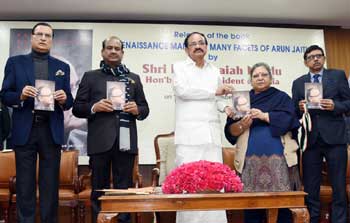– Arun jaitley –
The release of the Socio-Economic and Caste Census (SECC) on Friday offers an opportunity to reflect upon the strategy for uplifting the lives of India’s poor and vulnerable. While great strides have been made to improve the economic lives of the poor, deprivation of one kind or another is still high: for example, about 30 percent of households encounter at least two out of the SECC’s seven measures of deprivation[1] and 49 percent of households at least one. Improving this situation is the number one priority of this government.
But how can we achieve our objective most effectively and quickly? A permanent, formal sector, well-paid job is the best anti-poverty measure. The SECC reflects this conclusion: out of the seven measures of deprivation, the one that leads to the greatest amount of deprivation is being a landless household that derives a major part of its income from manual casual labour.
The way to eliminate deprivation is to achieve rapid economic growth of 8-10 percent so that good jobs are created for all Indians quickly. That is why the government is promoting investment.
There is an ambitious program to increase public investment in roads, railways, rural infrastructure and connectivity (the SECC shows, for example, that mobile penetration is only about a quarter in rural Chattisgarh).
At the same time, the government is creating the conditions for greater private investment: implementing the GST and creating a common market, reforming the land law, easing the costs of doing business, and unblocking stalled projects are all measures that will improve the conditions for investment.
The latest data suggest that the investment cycle is slowly turning around and stalled projects are being unblocked at a faster pace. Passing the GST and reforming the land law will accelerate this investment turnaround.
To re-inforce the effects of growth on alleviating deprivation, but also to help those that may be left out, we need targeted schemes and policies. The government has been helping the poor by giving them subsidies. But these are poorly targeted and leaky. If we can realize the government’s JAM—Jan Dhan Aadhaar, Mobile—vision we can ensure that money goes directly and more quickly into the pockets of the poor and from the savings we achieve we can put even more money for the poor.
The experience with the DBT scheme in LPG is very encouraging: research by the office of the Chief Economic Adviser shows that about Rs. 12,700 crores (25 percent) will be saved this year from the direct benefit transfer (DBT) scheme. If we can be careful in our design and implementation, we can extend DBT to other commodities, so that the poor get more money to spend for their upliftment.
In addition, we must help the poor by protecting them against risks of various kinds. For farmers, we need to use technology to provide more effective crop insurance to safeguard against weather and other catastrophic risks. For others, especially in the informal sector, we need social insurance against old age, illness and longevity. In the budget a number of social insurance schemes were announced, including the Pradhan Mantri Suraksha Bima Yojana, Pradhan Mantri Jeevan Jyoti Yojana, and Atal Pension Yojana. We intend to strengthen these schemes to encourage further take-up.
Growth or redistribution? Policy reforms or targeted anti-poverty schemes? We believe these are false choices. Both are necessary. Growth and economic reforms help the poor as do targeted schemes. That is the message we draw from the SECC.
_______________
Abaut The Author
Arun Jaitley
Arun Jaitley Minister of Finance, Information & Broadcasting and Corporate Affairs
—————
Disclaimer : The views expressed by the author in this feature are entirely his own and do not necessarily reflect the views of INVC.
—————————-
—————————–


 Abaut The Author
Abaut The Author













